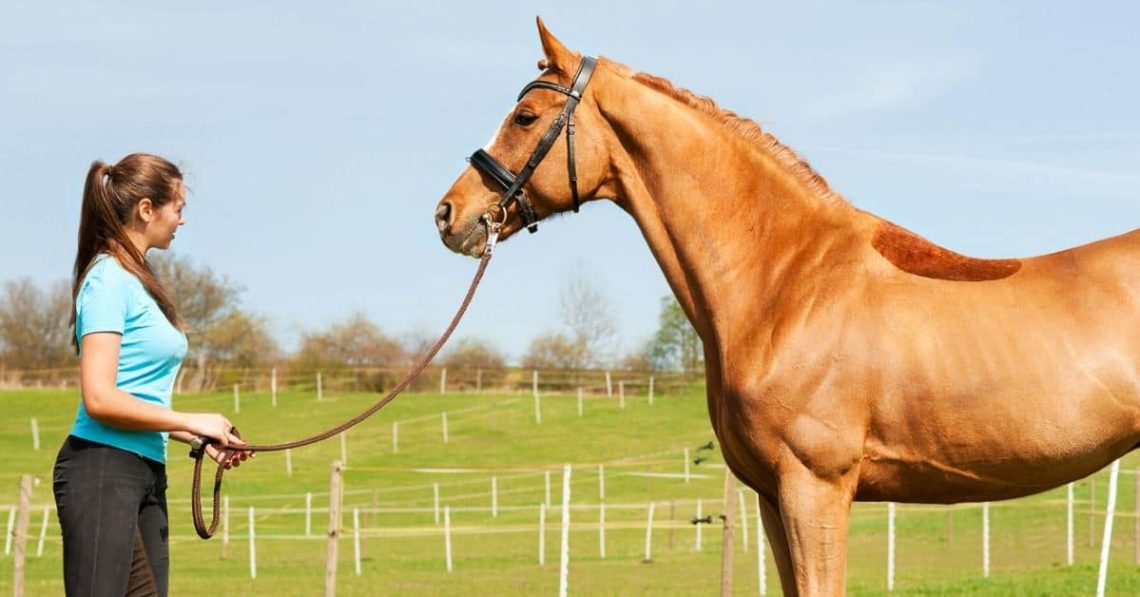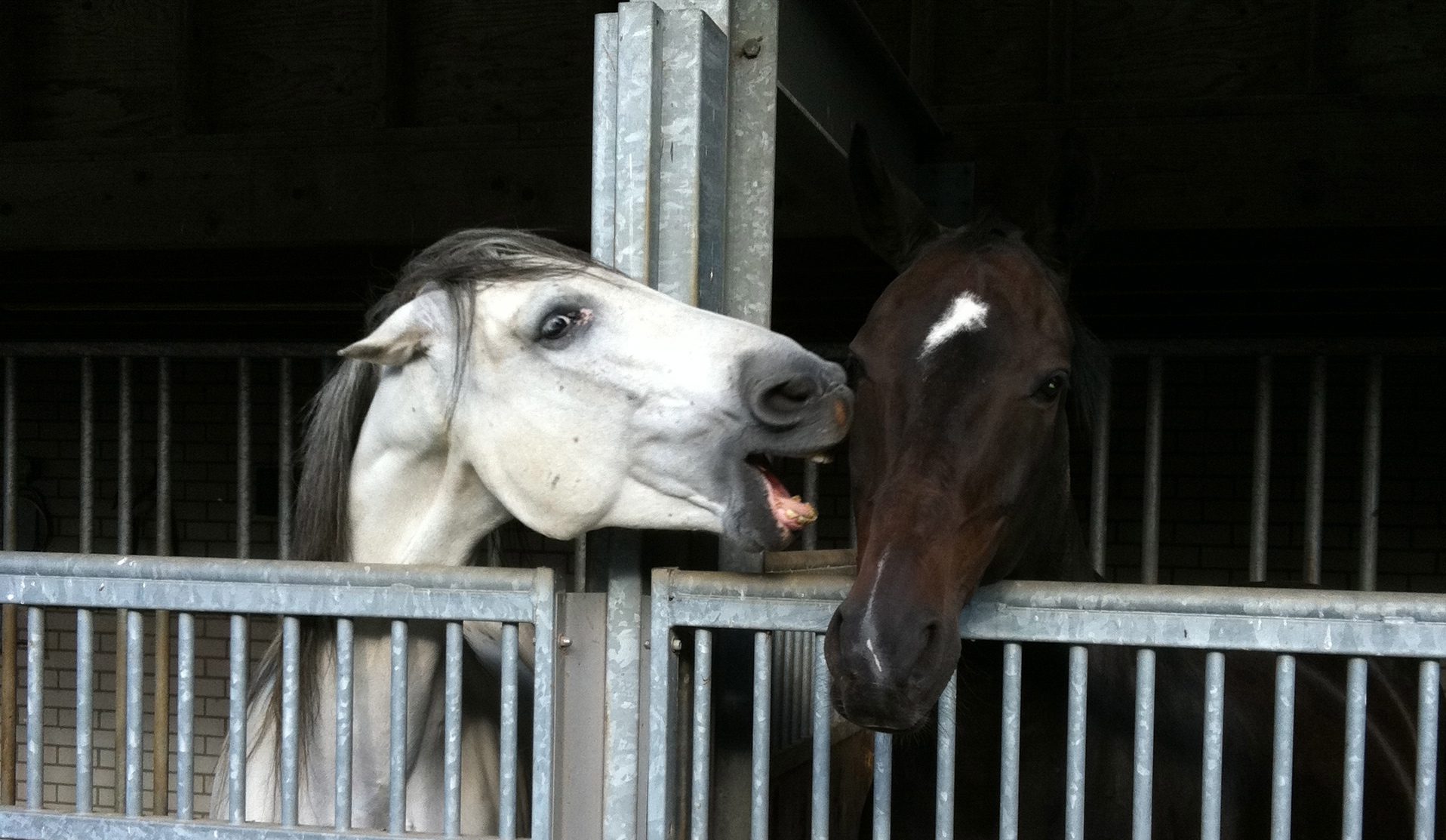
Horse safety on the ground
Horse safety on the ground
No matter what age, training level or breed you are working with, the horse must be safe on the ground. If you have no control of the horse on the ground, there is a good chance you will have even less control while riding. It is important to exercise caution and safety even if you are dealing with old horses or horses you have known for a long time, because there is always room for the unexpected. In this article, we will look at the basic principles of horse behavior, general precautions, and how to safely approach, lead, and tie a horse.
People are increasingly choosing horseback riding as their hobby. That is why materials are needed from which one could learn how to communicate with horses, exposing oneself to the least risk. The basics of safety are important in everything we do with a horse. Below we describe some of the most important precautions that must be taken to ensure that communication with the horse is safe and enjoyable.
Fundamentals of horse behavior
The keys to a good relationship with a horse are respect and patience. At the same time, the horse must also learn to respect the person who is next to it. To earn a horse’s respect, you must understand the basics of its behavior.
Horses survive in the wild thanks to their instinct to run away from danger – the “flight instinct”. That is why they often react to unfamiliar objects and circumstances, becoming frightened or running away from the object that frightened them. Horses detect danger with their sight, smell, and keen hearing. Remember that when a horse is seemingly frightened for no reason, he may be reacting to something he hears that you are not.
Horses see differently than people, they can be easily frightened by something sudden. They have a wide field of vision, but they also have blind spots – areas behind the croup and in front of the muzzle. The horse must change its head position to focus its vision, and when it focuses on one area, it cannot see others clearly. For example, when a horse lifts its head and turns its ears forward, it focuses on something far away. At the same time, the horse lowers its head, focusing on low, close objects. Watch out for blind spots and focus on what your horse is focused on. – so you can evaluate what can scare the horse!
Your horse’s ears will also give you hints. – they will indicate the direction in which the attention of the horse is focused. The ears, turned and “laid” back (called the “rat”), should alert you that the horse is about to strike or bite.

You should be able to tell the difference between ears that are simply turned back and down and ears that are “laid back”. The first ones tell you that the horse is just listening to what is happening behind him.
Horses have strong hind legs, so they use them for defense or when frightened by a sudden object. However, there are horses that kick and kick out of bad habit – it’s best for beginners to stay away from them until a professional fixes the problem!
Your movements around the horse should be calm and predictable. Nervous and fussy people make horses nervous too, creating an unsafe situation. Try to always be in a good mood and never blame the horse for your own mistakes. It is better to miss a day of communication with a horse than to take out your bad mood on it. It takes discipline to maintain safety when dealing with horses. At the same time, you must be calm and consistent. The horse should not suffer from outbursts of your bad mood. This will make dangerous situations even worse, either by scaring the horse or making it respond.
How to properly approach a horse
Approach the horse slowly, confidently and calmly.
When you catch free-roaming horse, approach her from the side of her left shoulder, holding the lead in the hand closest to the horse and the halter in the opposite hand. Move slowly but surely, talking to the horse as you approach. Watch her body language – so you can find out about her intentions. If the horse is trying to get away, slow down or step back and lower the lead and halter before the horse goes too far in the other direction. Be careful – if you corner the horse, he may try to hit you, believing that you are threatening him.
Some people use treats to lure and catch a horse, but it is best to teach a horse to catch without a food stimulant, especially if he is with other horses. Horses may circle you and inadvertently push or hit you.
As soon as you can touch the horse, scratch it on the neck and slowly place the end of the lead on the neck. If you make sharp and quick movements with your hands, the horse may run away from you. Standing next to the horse’s neck, put the halter on it. Do this carefully, without catching your eyes and without hitting your nostrils and ears. Rough handling can cause horses to interfere with the haltering process.
Adjust the halter so that it does not press – a fist should pass between the throat and the halter, no more. The halter should be tight enough to prevent the horse’s leg from getting into it when he bows his head.
Be careful when approaching a horse that is busy, such as when its head is in the feeder. When approaching a horse in a stall, speak to it to get its attention and wait until it turns around and faces you. In the stall it’s harder to avoid a dangerous situation, so always make sure you have escape routes open.
If you are approaching a horse that is tethered in a stall, make sure he moves back to give you room and a way to get to his face.
Talk to your horse and run your hand over his body as you move around him. Even if the horse is aware of your presence, he may be frightened by quick movements. When approaching from behind, approach at an angle. Talk to the horse, make sure he pays attention to you, and gently touch him as you walk past his rear.
How to lead a horse
When turning your horse, always move it away from you so that it does not accidentally step on you!
Hold the lead in your right hand at a distance of 20-25 cm from the horse’s head, in your left hand hold the free edge of the lead. If the horse is walking calmly, you can relax your right hand, but hold the lead firmly with your left. Always use a lead – this way you will always have a safe zone, and your hand will not get stuck in the halter if you held on to it in the absence of a lead, and the horse jerked its head sharply.
Teach the horse to walk beside you so that you can walk at your left shoulder. Keep your right elbow at the horse’s shoulder so you can control his actions. The horse must be able to move away from pressure, he must not lean on your arm and lean on it if you want to create distance between you by pulling it away with your elbow. If you are leading an unfamiliar horse, or a horse that tends to act abruptly, you can tie a lead lead over its nose for more control. Don’t let the horse walk on your legs. Don’t let him get behind you – he will be able to jump on you in case of a fright.
When changing direction, turn the horse away from you so that it does not step on you (see photo above).
When you guide the horse through doorway or gate, make sure that there is enough space so that she does not hit her sides. You must pass first. Then step aside, giving way to the horse, then let the horse pass. Be careful – some horses, when they are led through narrow spaces, try to get through quickly.
The free edge of the lead or cord should be in your left hand so that your hand does not get tangled in it (it) and you do not step into it with your foot. If the end is too long, fold it into neat little rings. In no case do not wind the lead, rope or cord around your arm – the horse can pull and thus cause you a serious injury (burn of the hand, dislocation or even fracture). Do not underestimate this danger! Many grooms, amateurs and professionals, have been seriously injured in this way.
If your lead has a chain, do not fasten it with a ring. The horse can lower its head and step into it. Place the chain over the horse’s nose, or pass it through the ring, then through the first cheek ring, and fasten it to the second cheek ring where the halter fastens.
How to tie a horse
There are two ways to tie a horse: with one lead or two (put on junctions). If using a single lead, tie it to a strong anchor such as a post or ring in a solid wall, and use a secure knot that can be quickly untied in one motion (see picture below). Some horses can learn how to tie a secure knot, so you may need to put the end through a loop.
Always tie your horse by the lead, not the reins, do not attach the lead to the snaffle rings! When tying a horse to a hitching post, try to do it in such a way that it does not fight with nearby horses. Also tie her away from the end of the hitching post so that she cannot go around it and stand on the other side.
When tying a horse, use secure knots.
Tie the lead at the level of the withers of the horse. It should be short enough so that the horse cannot lower his head and step into the loop with his foot. The horse should be able to stand with his head raised to a comfortable level. Never tie your horse to wire fences, and in places where the knot can slip to ground level, do not tie it to something that could fall if the horse pulls the lead. When tying a horse in a stall, do not fasten the lead to the door – in a panic, the horse can pull the door off its hinges and drag it along.
Do not leave a horse unattended on a leash, especially if there are no other horses nearby. The horse is a herd animal, it can panic if you leave it alone, and in doing so injure itself or the person who tries to free it.
Interchanges can become dangerous if they are built in violation of the rules. Interchanges should be installed only where there are reliable supports. It is desirable that there is a wall behind at some distance that will stop the horse moving backwards. Use safety carabiners and fasten them high up on the walls so the horse can’t kick them if it gets exposed. Reinforcements should be made of a material that can be cut quickly and should provide enough tension to keep the horse’s head in a comfortable position. Do not use rubber bands. If the horse starts to back up or jerks forward sharply, they can break.
Always unfasten the reins before removing the halter from the horse. When leading a horse into a levada or into a stall, always turn its head towards the exit. If you are leaving a horse with a halter in a levada, we recommend opting for a leather halter rather than a synthetic halter. Leather is not as strong and will break if the horse gets his foot stuck in it or gets caught on something.
After you remove the halter, ask the horse to stand quietly next to you for a few seconds before releasing it. This will help prevent the horse from getting into the habit of immediately running away from you with “goats” (this is not safe, because it can hit you). Make sure you have a way to back off if the horse suddenly turns around and kicks to your side.
Grooming
Always wear boots or boots with a hard toe to protect your feet (the horse can step on them). Do not wear sandals or open-toed sandals. Also avoid wearing dangling jewelry, including earrings, and loose long hair.
Brush your horse gently, especially if he has sensitive skin. Some horses may resent and snarl if they are uncomfortable during brushing. Do not leave brushes and similar things on the floor near the horse – he may step on them!
Stand next to the horse, put one hand on his body – this way you will follow his movements during cleaning. Never sit on the ground or kneel near a horse – you must always be ready to jump to the side. Take your time, especially if you are grooming a young or shy horse.
Start cleaning with a rubber comb, it is “softer” than a metal one. Start at the neck, brushing in circular motions. Move from front to back, carefully working on the places where the bones are just under the skin. Avoid using the comb on the muzzle, lower legs and groin.
You can use a hair removal blade, but be careful in areas where the bones are close to the skin. Do not use the blade on the mane, tail or legs.
After you’ve brought the dirt and loose hair to the surface, use the brush to remove it. If you have two brushes, use the stiffer bristle brush first. Start at the neck and work your way through the coat, working from front to back. Be sure to treat the horse’s stomach in the place where the girth will lie so that wounds and scuffs do not form there.
A stiff brush can be used to remove dried dirt on the feet by moving from side to side. But it may be better to wash this mud with water – it will be more comfortable for the horse and safer for you.
Use a soft brush as a final touch to clean the horse’s face. Untie the horse, work slowly and carefully, as many horses are sensitive in the muzzle and ear area. Hold the lead in one hand, or wrap the end around the horse’s neck and place your hand on his nose so he doesn’t hit you if he swings his head. Start at the forehead and be careful working around the eyes, mouth and nose. Avoid leaning towards the horse and bringing your face close to his muzzle – he may turn his head sharply and hit you.
When brushing the hind legs and tail, stand on the side next to the horse near his hind leg. If you must stand behind the horse, make sure you can quickly jump back if something spooks the horse in front. When treating the flanks and loins, watch the horse’s reaction. If she shows anxiety, brush these areas more gently and gently.
Use a soft brush when cleaning the mane and tail. Tangled places are best sorted with your fingers, but special combs can also be used.
If you are walking behind a horse, stay as close to it as possible and lead it with your hand. If the horse kicks, the kick won’t have time to gain momentum, and if the horse hits you, the damage won’t be very serious. If you go around the back of the horse and keep even a meter away from him, you can get a full force blow, which can be deadly. If you don’t want to move close, walk around the horse so far that he can’t hit you at all, make sure the horse is aware of your presence when you approach the other side of it.
When you are working with a horse in a stall, move close to him, because there will not be enough room for you to move safely. When you are working with shy or unfamiliar horses, stand at a safe distance to the side and run your hand over the rump to check the horse’s reaction.
Do not pass over or under interchanges. The horse may step back and you will lose your balance if you are over the junction. If the horse runs forward or tries to hit or bite you, you will not be able to quickly retreat. Never try to pass under the horse’s belly.
If the horse is wearing an anti-bite collar, remove it before cleaning or handling, especially if you are going to clip the horse. If something frightens her, he can lift his head high, and the collar will cut off the oxygen supply.
Hoof hooking
Hooves should be unhooked daily, every time you brush your horse, and before and after every ride.
Start with the left forefoot and work your way around to the right forefoot, as most horses are used to that order. Standing at the front of the horse, place the hand closest to him on his shoulder, and with the other hand, run down the leg and press on the tendon above the fetlock below. If the horse doesn’t lift his leg, press on his shoulder to shift his weight to the opposite side, or squeeze the tendon harder until the horse lifts his leg. If you try to get your horse’s foot off the ground, it’s only natural that he will lose his balance and lean on you.
As soon as the horse lifts the leg, take it by the hoof with the outside hand and lift it up to the level of the carpal joint, the movements should not be sharp, do it smoothly and quickly. Hold the leg firmly enough that the horse cannot pull it back. If the horse is restless and struggling, put your foot back in place and start over. Make sure your feet are out of the “kill zone” and the horse won’t step on and kick you if he jerks him out of your hands.
Work crochet down towards the hook. Never move from the toe to the heel, as you will puncture the frog or sole if the horse twitches violently.
Clean sole, frog and around frog . Be careful, try not to miss naminas, punctures, foreign objects, pay attention to possible signs of illness. If you find a problem, check with your veterinarian or farrier.
To unhook the hindhoof, put your hand on the horse’s thigh, he should shift his weight in the opposite direction. This will also allow you to push the horse away if it tries to hit you. With the other hand, guide the leg down to the fetlock, using the same procedure as with the front leg, to ask the horse to raise the leg. When the horse lifts its leg, wrap your hand around the hoof. Pull your leg back a little and lift it up, either holding it in your hand or resting it on your thigh at your knee. Let the horse relax into a comfortable position. Don’t pull your leg too high or move it too far back as this will throw the horse off balance. Stand so that you are not behind the horse if it starts to resist. When you’re done, slowly lower your leg down, don’t drop it.
General Precautions
Children who work with a horse must be supervised by an adult. Even the best horse can accidentally step on a small child if he gets under his foot. Make sure children are aware of all safety precautions. Some tasks, such as unhooking, can be difficult for children, so make sure that the child is supervised during this procedure, he has enough strength and skills for this task.
Another safety measure (and concern for your horse) is insect control.
Spray the horse in the same positions as when brushing. Make sure the horse understands your intentions and untie him if he is afraid and tries to rein. If the horse is too nervous, put some spray on a towel and rub it over the horse. Follow the same procedure around the muzzle, avoid getting the product in the eyes. Always read the labels on the sprays and take into account the precautions indicated on them.
Also observe the following safety rules:
- Certain types of clothing (for example, rustling jackets and raincoats) can frighten a horse. Let the horse get used to them or take them off. Strange objects such as umbrellas can also produce a similar effect. Respect stable workers and people nearby – try not to endanger them.
- Do not run or play in the stable or start work that may frighten horses without alerting grooms, groomsmen, riders and other stable workers. There may be people in the stalls with horses who can get hurt if you suddenly start making noise. This applies to activities such as hammering nails, work associated with moving under the ceiling of the stable, on top of the stalls, dropping hay from the attic, etc.
- Some horses become aggressive while feeding, so leave them alone while they eat. Avoid hand-feeding these horses, especially sweets. Some horses begin to expect treats and this may develop into a biting habit. Never tease horses.
- Periodically check the stalls for protruding nails and broken boards.
- Keep the stable free of debris and unnecessary items. Clean up any tools and equipment after use.
- Keep electrical wires completely out of reach of horses. They may try to chew on the cord or step on it. The result can be an electric shock. Do not leave the cords unattended even for a minute – the horse can detect them quite quickly. Do not leave electric fans or similar equipment running overnight or unattended.
- If you don’t have experience with lip wrenches, leave the job to experienced people. Be sure you are familiar with and able to work with such items before applying them to a horse. Less experienced barn staff should be supervised when using lip rollers, as some horses may overreact and try to hit or run away. If the lip runner is not used properly, it can injure the horse.
- Do not smoke in the stable and never mix alcohol or drugs with equine activities.
- The stable should have a first aid kit for humans, as well as a first aid kit for horses. Make sure someone in your stable is trained in CPR and first aid.
- Print out all emergency numbers. Laminate the sheet and place it in an accessible and visible place, preferably next to the phone. The telephone numbers of the stable owner, manager and coaches must also be publicly available. If you are the owner, you must have the phone numbers of all employees, visitors, private owners and parents of minor children.
- Take special care when working with young horses or horses with spoiled temperaments. These animals are best left in the care of professional trainers until they are safe for hobbyists.
All horses are different, and what may be safe with one horse may be extremely dangerous with another. If you are in doubt that your horse will complete a task safely, consult an experienced trainer or handler. Make safety practices a part of your daily routine until it becomes a habit.
Wayne Loch, Department of Animal Sciences (source); translation by Valeria Smirnova.
 Vladimir123 10th of January 2018
Vladimir123 10th of January 2018Very interesting article, thanks)





